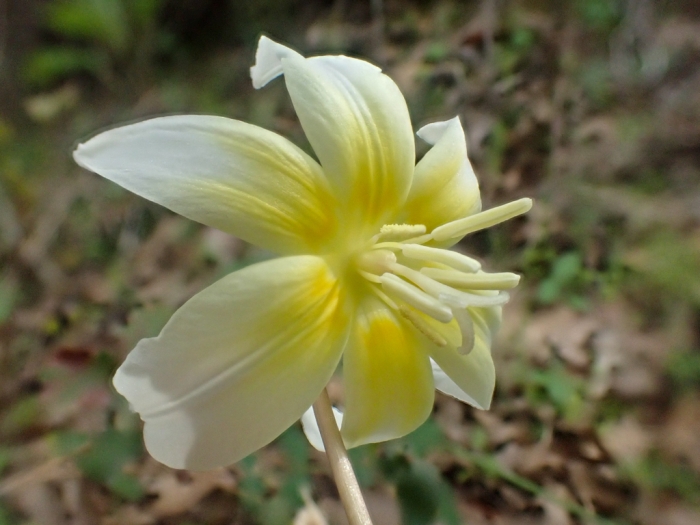Sierra Fawn Lily
(Erythronium multiscapideum)
Sierra Fawn Lily (Erythronium multiscapideum)
/
/

© Chloe and Trevor Van Loon
CC BY 4.0
Image By:
© Chloe and Trevor Van Loon
Recorded By:
Copyright:
CC BY 4.0
Copyright Notice:
Photo by: © Chloe and Trevor Van Loon | License Type: CC BY 4.0 | License URL: http://creativecommons.org/licenses/by/4.0/ | Uploader: chloe_and_trevor | Publisher: iNaturalist |

























Estimated Native Range
Summary
Erythronium multiscapideum, commonly known as Sierra fawn lily, is a perennial herb endemic to California, specifically found in moist meadows, open woodlands, and forest clearings within the foothills of the southern Cascade Range and the Sierra Nevada from Shasta County to Amador County, as well as isolated populations in Mariposa County. It typically grows from a bulb 0.8-2 inches long and features two oval-shaped, mottled leaves up to 6 inches long. The plant reaches a modest height of 4-8 inches and produces 1-4 nodding white flowers with bright yellow bases and brownish-red exteriors on the back of the petals, each bloom appearing in early spring. The flowers are quite showy and attract pollinators such as bees.
Sierra fawn lily is valued for its delicate, ornamental flowers and its ability to naturalize in suitable conditions. It is often used in woodland gardens, rock gardens, and native plant landscapes. This species prefers partial shade and requires moist, well-drained soils rich in organic matter. While it is relatively low-maintenance, it is important to avoid waterlogged conditions, which can lead to bulb rot. There are no major disease issues, but slugs and snails can sometimes be problematic. Erythronium multiscapideum is not known for being invasive and does not have aggressive roots, making it a safe choice for most gardens.CC BY-SA 4.0
Sierra fawn lily is valued for its delicate, ornamental flowers and its ability to naturalize in suitable conditions. It is often used in woodland gardens, rock gardens, and native plant landscapes. This species prefers partial shade and requires moist, well-drained soils rich in organic matter. While it is relatively low-maintenance, it is important to avoid waterlogged conditions, which can lead to bulb rot. There are no major disease issues, but slugs and snails can sometimes be problematic. Erythronium multiscapideum is not known for being invasive and does not have aggressive roots, making it a safe choice for most gardens.CC BY-SA 4.0
Plant Description
- Plant Type: Herb, Bulb
- Height: 0.25-0.6 feet
- Width: 0.5-1 feet
- Growth Rate: Moderate
- Flower Color: White
- Flowering Season: Spring
- Leaf Retention: Deciduous
Growth Requirements
- Sun: Full Sun, Part Shade
- Water: Medium
- Drainage: Medium
Common Uses
Bee Garden, Butterfly Garden, Low Maintenance, Rock Garden
Natural Habitat
Moist meadows, open woodlands, and forest clearings within the foothills of the southern Cascade Range and the Sierra Nevada
Other Names
Common Names: Many-Stemmed Fawn Lily, Kotolo, Sierra Foothills Fawn-Lily
Scientific Names: , Erythronium multiscapideum, Erythronium grandiflorum var. multiscapideum, Erythronium hartwegii, Erythronium multiscapoideum, Fritillaria multiscapidea, Fritillaria multiscapoidea,
GBIF Accepted Name: